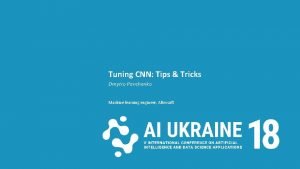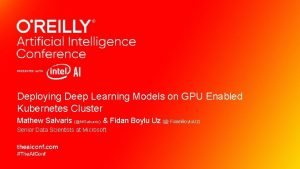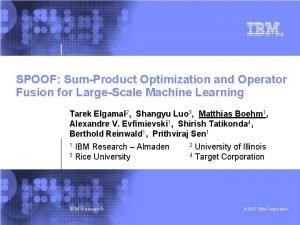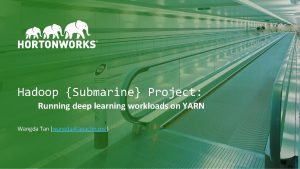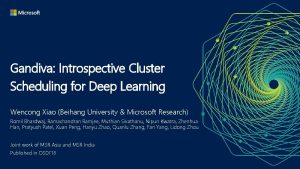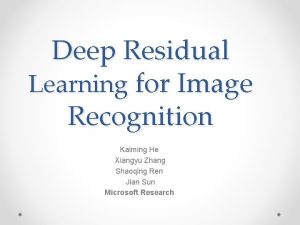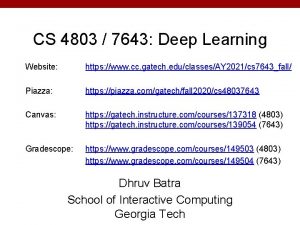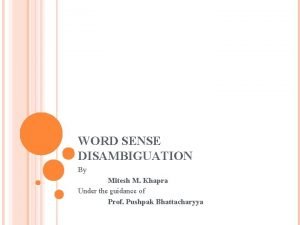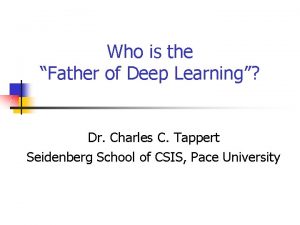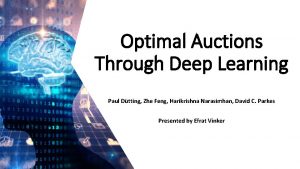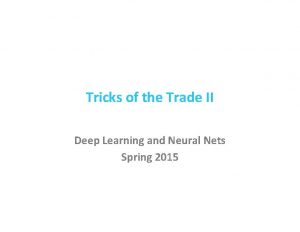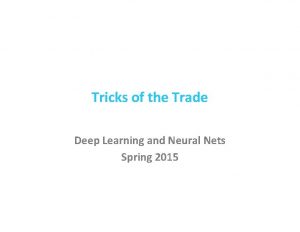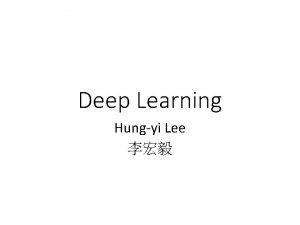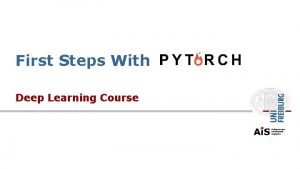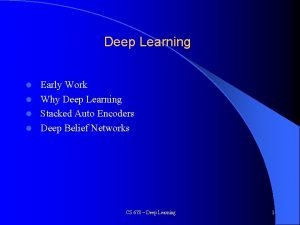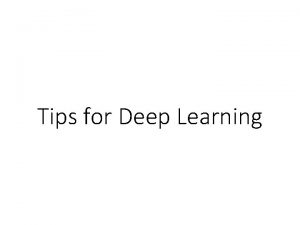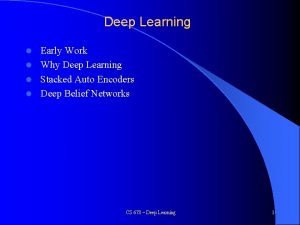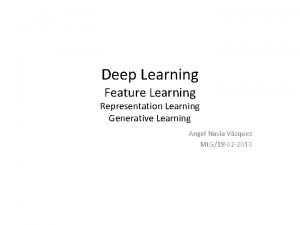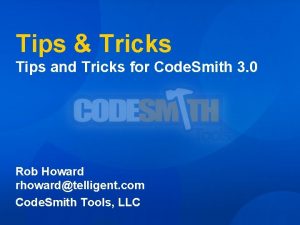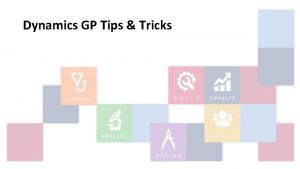Tricks of the Trade II Deep Learning and



























- Slides: 27

Tricks of the Trade II Deep Learning and Neural Nets Spring 2015

Agenda 1. Review 2. Discussion of homework 3. Odds and ends 4. The latest tricks that seem to make a difference

Cheat Sheet 1 ü Perceptron § Activation function § Weight update ü Linear associator (a. k. a. linear regression) § Activation function § Weight update assumes minimizing squared error loss function

Cheat Sheet 2 ü Two layer net (a. k. a. logistic regression) § activation function § weight update ü Softmax net (a. k. a. multinomial logistic regression) § activation function § weight update assumes minimizing squared error loss function

Cheat Sheet 3 ü Back propagation § activation function § weight update ü assumes minimizing squared error loss function

Cheat Sheet 4 ü Loss functions § squared error § cross entropy

How Many Hidden Units Do We Need To Learn Handprinted Digits? ü ü ü Two isn’t enough Think of hidden as a bottleneck conveying all information from input to output Sometimes networks can surprise you § e. g. , autoencoder

Autoencoder ü ü Self-supervised training procedure Given a set of input vectors (no target outputs) Map input back to itself via a hidden layer bottleneck How to achieve bottleneck? § Fewer neurons § Sparsity constraint § Information transmission constraint (e. g. , add noise to unit, or shut off randomly, a. k. a. dropout)

Autoencoder and 1 -of-N Task ü Input/output vectors § § § § ü 10000000 01000000 00100000 000100001000 00000100 00000010 00000001 How many hidden units are require to perform this task?

When To Stop Training ü 1. Train n epochs; lower learning rate; train m epochs § bad idea: can’t assume one-size-fits-all approach ü 2. Error-change criterion § stop when error isn’t dropping § My recommendation: criterion based on % drop over a window of, say, 10 epochs 1 epoch is too noisy absolute error criterion is too problem dependent § Karl’s idea: train for a fixed number of epochs after criterion is reached (possibly with lower learning rate)

When To Stop Training ü 3. Weight-change criterion § Compare weights at epochs t-10 and test: § Don’t base on length of overall weight change vector § Possibly express as a percentage of the weight § Be cautious: small weight changes at critical points can result in rapid drop in error

Setting Model Hyperparameters ü How do you select the appropriate model size, i. e. , # of hidden units, # layers, connectivity, etc. ? § validation method split training set into two parts, T and V train many different architectures on T choose the architecture that minimizes error on V § fancy Bayesian optimization methods are starting to become popular

The Danger Of Minimizing Network Size ü My sense is that local optima arise only if you use a highly constrained network § minimum number of hidden units § minimum number of layers § minimum number of connections § xor example? ü Having spare capacity in the net means there are many equivalent solutions to training § e. g. , if you have 10 hidden and need only 2, there are 45 equivalent solutions

Regularization Techniques ü ü Instead of starting with smallest net possible, use a larger network and apply various tricks to avoid using the full network capacity 7 ideas to follow…

Regularization Techniques 1. early stopping Rather than training network until error converges, stop training early Rumelhart § hidden units all go after the same source of error initially -> redundancy Hinton § weights start small and grow over training § when weights are small, model is mostly operating in linear regime Dangerous: Very dependent on training algorithm § e. g. , what would happen with random weight search? While probably not the best technique for controlling model complexity, it does suggest that you shouldn’t obsess over finding a minimum error solution.

Regularization Techniques 2. Weight penalty terms L 2 weight decay L 1 weight decay weight elimination See Reed (1993) for survey of ‘pruning’ algorithms

Regularization Techniques 3. Hard constraint on weights Ensure that for every unit If constraint is violated, rescale all weights: [See Hinton video @ minute 4: 00] I’m not clear why L 2 normalization and not L 1 4. Injecting noise [See Hinton video]

Regularization Techniques 6. Model averaging Ensemble methods Bayesian methods 7. Drop out [watch Hinton video]

More On Dropout ü ü With H hidden units, each of which can be dropped, we have 2 H possible models Each of the 2 H-1 models that include hidden unit h must share the same weights for the units § serves as a form of regularization § makes the models cooperate ü Including all hidden units at test with a scaling of 0. 5 is equivalent to computing the geometric mean of all 2 H models § exact equivalence with one hidden layer § “pretty good approximation” according to Geoff with multiple hidden layers

Two Problems With Deep Networks ü ü Credit assignment problem Vanishing error gradients § note y(1 -y) ≤ 25

Unsupervised Pretraining ü Suppose you have access to a lot of unlabeled data in addition to labeled data § “Semisupervised learning” ü Can we leverage unlabeled data to initialize network weights? § alternative to small random weights § requires an unsupervised procedure: autoencoder ü With good initialization, we can minimize credit assignment problem.

Autoencoder ü ü Self-supervised training procedure Given a set of input vectors (no target outputs) Map input back to itself via a hidden layer bottleneck How to achieve bottleneck? § Fewer neurons § Sparsity constraint § Information transmission constraint (e. g. , add noise to unit, or shut off randomly, a. k. a. dropout)

Autoencoder Combines An Encoder And A Decoder Encoder

Stacked Autoencoders . . . copy deep network ü Note that decoders can be stacked to produce a generative model of the domain

Rectified Linear Units § Version 1 § Version 2 § Do we need to worry about z=0? § Do we need to worry about lack of gradient for z<0? § Note sparsity of activation pattern § Note no squashing of error derivative

Rectified Linear Units Hinton argues that this is a form of model averaging

Hinton Bag Of Tricks ü ü ü Deep network Unsupervised pretraining if you have lots of data Weight initialization § to prevent gradients from vanishing or exploding ü ü ü Dropout training Rectified linear units Convolutional NNs if spatial/temporal patterns
 Deep learning approach and surface learning approach
Deep learning approach and surface learning approach Deep learning vs machine learning
Deep learning vs machine learning Dmytro panchenko
Dmytro panchenko Deep asleep deep asleep it lies
Deep asleep deep asleep it lies Deep forest: towards an alternative to deep neural networks
Deep forest: towards an alternative to deep neural networks 深哉深哉耶穌的愛
深哉深哉耶穌的愛 Trade diversion and trade creation
Trade diversion and trade creation Umich
Umich Which is the most enduring free trade area in the world?
Which is the most enduring free trade area in the world? Trade diversion and trade creation
Trade diversion and trade creation Liner trade and tramp trade
Liner trade and tramp trade Cuadro comparativo e-learning b-learning m-learning
Cuadro comparativo e-learning b-learning m-learning The trade in the trade-to-gdp ratio
The trade in the trade-to-gdp ratio Fair trade not free trade
Fair trade not free trade What is triangle trade
What is triangle trade Autoencoders, unsupervised learning, and deep architectures
Autoencoders, unsupervised learning, and deep architectures Kubernetes vgpu
Kubernetes vgpu Operator fusion deep learning
Operator fusion deep learning Andrew ng recurrent neural networks
Andrew ng recurrent neural networks Hortonworks gpu
Hortonworks gpu Gandiva: introspective cluster scheduling for deep learning
Gandiva: introspective cluster scheduling for deep learning He kaiming
He kaiming Deep learning speech recognition
Deep learning speech recognition Cs 4803
Cs 4803 Wsbgixdc9g8 -site:youtube.com
Wsbgixdc9g8 -site:youtube.com Mitesh m khapra
Mitesh m khapra Who is the father of deep learning?
Who is the father of deep learning? Dtting
Dtting


